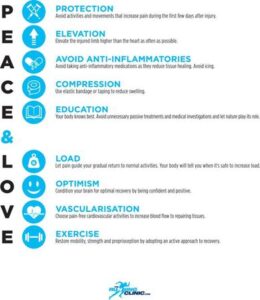Ice delays recovery, prevents inflammation and delays healing
This might come as a surprise. After all, putting ice on an injury has been something we have always been advised to do for many years, and with a simple Dr google search, you will find this advice still exists today.
But in the lastest

PEACE and LOVE your injury
Protection
If you can limit putting any weight through it, this is the REST portion so that you can minimise bleeding, or further tissue injury.
The aim here is to give a bit of respite but not too much. So look to unload within those first 1-3 days, and then you can gently start to put weight through. Use pain as your guide. Prolonged rest is no longer advisable. Get in and see us for an evaluation under ACC so we can guide you back to better movement and comfort. Our osteopaths can also work in conjunction with your physio to help reduce your pain whilst you are undertaking a rehab programme.
Elevate
This one stays – elevation helps with swelling. If practical, place your affected area above the heart as often as possible. This improves the drainage of the injury and aids in clearing excess fluid from the area. If you cannot place the affected area above the heart, getting it as high as possible will still do the job.
Really gentle movements are helpful in the early stages of your injury to help with decreasing the swelling, but use pain as a guide, keeping it pain free. If your swelling isn’t budging, or you are in too much pain, our team can assist until you can do the movements yourself. Our massage therapists specialise in flushing out stubborn fluid retention using very gentle techniques.
Avoid Anti-Inflammatories
Anti-inflammatories is in the name; they prevent inflammation. Inflammation after an injury, although painful and uncomfortable, has a role in getting you better. Signs of inflammation mean the body is healing and repairing your injury. So if high doses of anti-inflammatories are taken, this will delay your healing long term.
Compression
Compression, along with elevation are helpful tools to use. Using taping or compression bandages helps to limit the swelling AND helps support any damage to the tissue and reduces bleeding. Win-Win. It also feels better to be supported as much as possible.
Education
Ok, so this is where we come in. Regardless of your injury, coming in and getting it checked can get you on the right path quicker. It may seem like a small situation, you may not have even been injured, instead…nearly fallen or nearly rolled an ankle. Getting checked makes sure nothing else went into spasm or is contributing to your situation.
If you have been referred by your GP to a physio and you are on the right path with a rehab exercise/stretch plan, we can assist with your pain and discomfort with our hands on treatment. No one likes to do things that hurt! We can help alleviate that discomfort so you can do that rehab plan. If you have not been referred to a physio, we can do this for you! Our assessments and treatments will ensure you are on the right path to a full recovery.
Our approach is to treat you and your injury…..not just your injury.
We do this by following the LOVE protocol below.LOAD
We see a lot of people who have been given stretches/exercises that don’t work or can’t be done…………yet.
Our job is to get you to a place where you are able to start moving your injury; appropriately. This will promote repair, tissue healing and restores your capacity to tolerate movements. Because the body responds positively to appropriate movement, we need to find out where you are at and what movements we can give you to help rehab you back to pre-injury.
OPTIMISM
This again falls on us to make sure that you understand the problem, how long it will take and what you need to do, in conjunction with our treatments. The reality is, our aim is to get you back to being as self-sufficient as possible, so you no longer need our help. When you know what to do, then you feel much better and in control of your recovery – feeling confident in your post-injury journey is a non-negotiable.
VASCULARISATION
Under our guidance, pain-free cardiovascular exercise is advised as part of your rehab to optimise your blood flow within your body, and to and from the injured site. Done right, this type of exercise also helps to provide pain relief: you can do more, move better and it can reduce any dependence on pain medication. We will work with you to discover what form of exercise is possible. We may suggest after 3-4 days low impact exercises such as using the pool, walking, cross-trainer, rower or using a stationery bike.
EXERCISE
This really sums up everything that we have discussed above. The exercises we want to provide you with are all the ones specific to your injury. Ones that help provide you with increased strength, better movement, and greater awareness for a better recovery. Our recovery management must work with you to provide specific exercises and stretches according to where you are at and what you are able to do.
Our explanation will also look into WHY this might have happened in the first place. For example, if you have sprained an ankle, and you are prone to ankle sprains, we would also look at how we can prevent this from occurring again for you long term. We hope this information has been helpful and you will give PEACE a chance, because perhaps all soft tissue injuries need is LOVE.

